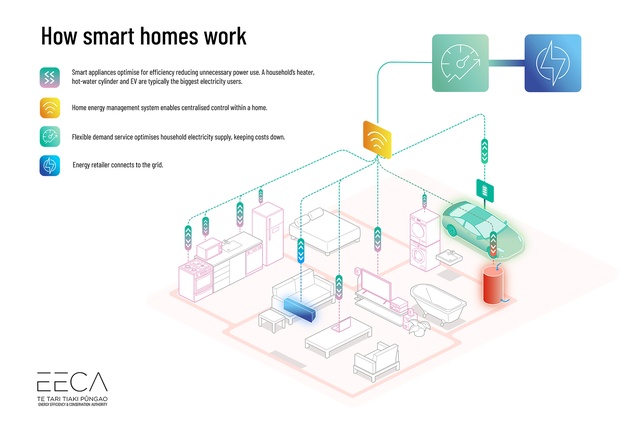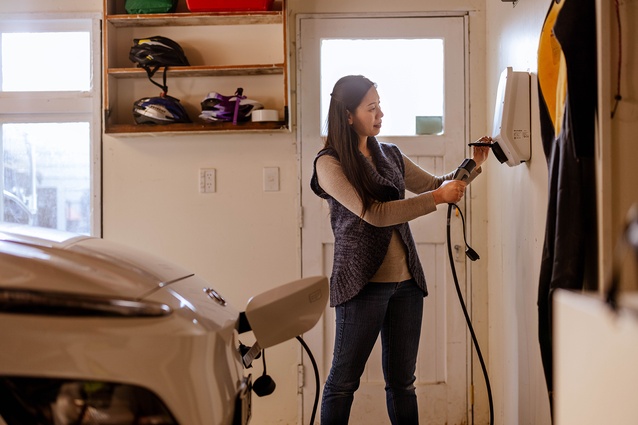Homes are set to get smarter
The introduction of Smart Homes will lower household energy bills and support New Zealand’s transition to renewables says the EECA (Energy Efficiency and Conservation Authority), and that Kiwis will soon have access to a new approach to household energy that will make the most of their home energy supply — reducing bills and relieving pressure on the national electricity grid.
To support this transition EECA has commissioned new guidance to help explain what smart appliances are, what a smart home is, and how we stand to benefit.
The guidance will also help New Zealanders understand how to make their existing home ‘smart’ to reduce energy costs and lower New Zealand’s carbon footprint by prioritising the use of renewable energy sources.
A smart home is a house that has two-way communication between its appliances/devices and the national electricity grid. In a fully set up smart home, this communication typically happens via a ‘flexibility supplier’ — a service to help manage the load on the grid — that can save you money and minimise unnecessary energy use. A smart home makes sure your needs are always met while also managing the overall demand on the electricity supply network.
EECA Technical Lead, Brian Fitzgerald, says homeowners and tenants with smart homes will only be drawing the electricity they need, and at the best available price.
“In a Smart Home, appliances will have the capability to ‘learn’ when you use them and to save energy when you don’t,” said Fitzgerald.
“Your electricity bills can be lowered by running your appliances more efficiently and shifting your energy use to periods of least cost electricity.”
Smart technologies will also support a broader shift to renewable energy and avoid greater electricity infrastructure costs. Given the New Zealand electricity grid is around 80% renewable, better utilising the energy we use in our homes with a smart home, will reduce the demand for the other 20% which comes from burning fossil fuels mostly at times of high demand.
“Using electricity better will also help reduce the need for more generation and electricity infrastructure as different sectors move away from fossil fuels — like transport, where deployment of EVs is on the rise,” said Fitzgerald.
For a smart home to work, your appliances need to either have ‘smart’ capability built into them or be connected to a ‘smart’ plug or thermostat. A smart home can also include a home energy management system (HEMS), that links all the smart appliances in your home together in a network.
“Using a ‘smart’ thermostat for hot water usage, for example, will map household patterns and respond to periods of low demand — like when householders are at work or at school,” said Fitzgerald.
Fitzgerald says that while full functionality is not there yet, smart homes are close, and it’s time to start getting ready.
“Any home can be smart, regardless of whether you rent or own. The set-up largely focuses on technology, rather than the building,” said Fitzgerald.
“Most New Zealanders will be able to live in a smart home without needing to head out and buy brand new appliances.
“The transition to smart appliances has quietly been underway for some time, and you might be surprised by the capability of things you already own — like the majority of heat pumps purchased in the last decade.”
In EECA’s guidelines, the transition to smart homes is outlined as being a two-step process.
The first step, is looking at what you will need to do to make your existing home appliances ‘smart’. A smart plug is an easy way to add ‘smartness’ when the technology is not built-in and you are not ready for an upgrade. A home energy management system (HEMS) — a simple device that monitors all of the smart devices in your home network and ensures optimised choices are made can also be set up now.
“It is important to check with retailers as the term ‘smart’ is sometimes used to describe a device that can speak to an app on a mobile phone, rather than one that is able to connect in with a flexibility supplier,” said Fitzgerald.
The second step, is connecting to a ‘flexibility supplier’. Fitzgerald says that while this service isn’t yet available in New Zealand, we can expect it within the next year or so.
Find EECA’s Smart Homes guidance here: Guidance for smart homes | EECA
Find Gen Less Smart Homes information here: Explore smart homes | Gen Less











